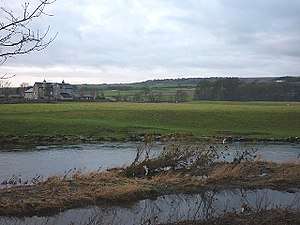Alavana
Alavana or Alauna[1] was a Roman fort in Britain, tentatively identified with the ruins at Watercrook about 2 mi (3.2 km) south of Kendal in Cumbria.[2]

The fort at Watercrook was erected around AD 90, originally in timber but then redone in stone around the year 130 during the reign of Hadrian. The fort was abandoned for about 20 years during the Antonine occupation of Scotland. It is noted as Alone or Alona in the Antonine Itinerary (where it is placed 18 m.p. from Galava and 19 m.p. from Calacum) and as Alunna in the Ravenna Cosmography (where it is placed between Mamucium and Cambodunum). It was refurbished under Marcus Aurelius and occupied until around 270, when its military units departed.[3] Its remains are now largely buried beneath a local farm, while excavated artifacts are displayed at the Kendal Museum.
References
- Esmonde Cleary, A. & al. "Places: 89102 (Alone?/Alauna?)". Pleiades. Accessed 12 Feb 2013.
- Roman Britain. "Alavana". Archived 2014-09-08 at the Wayback Machine 28 Sept 2010.
- Shotter, David. "The Roman fort at Watercrook (Kendal)".